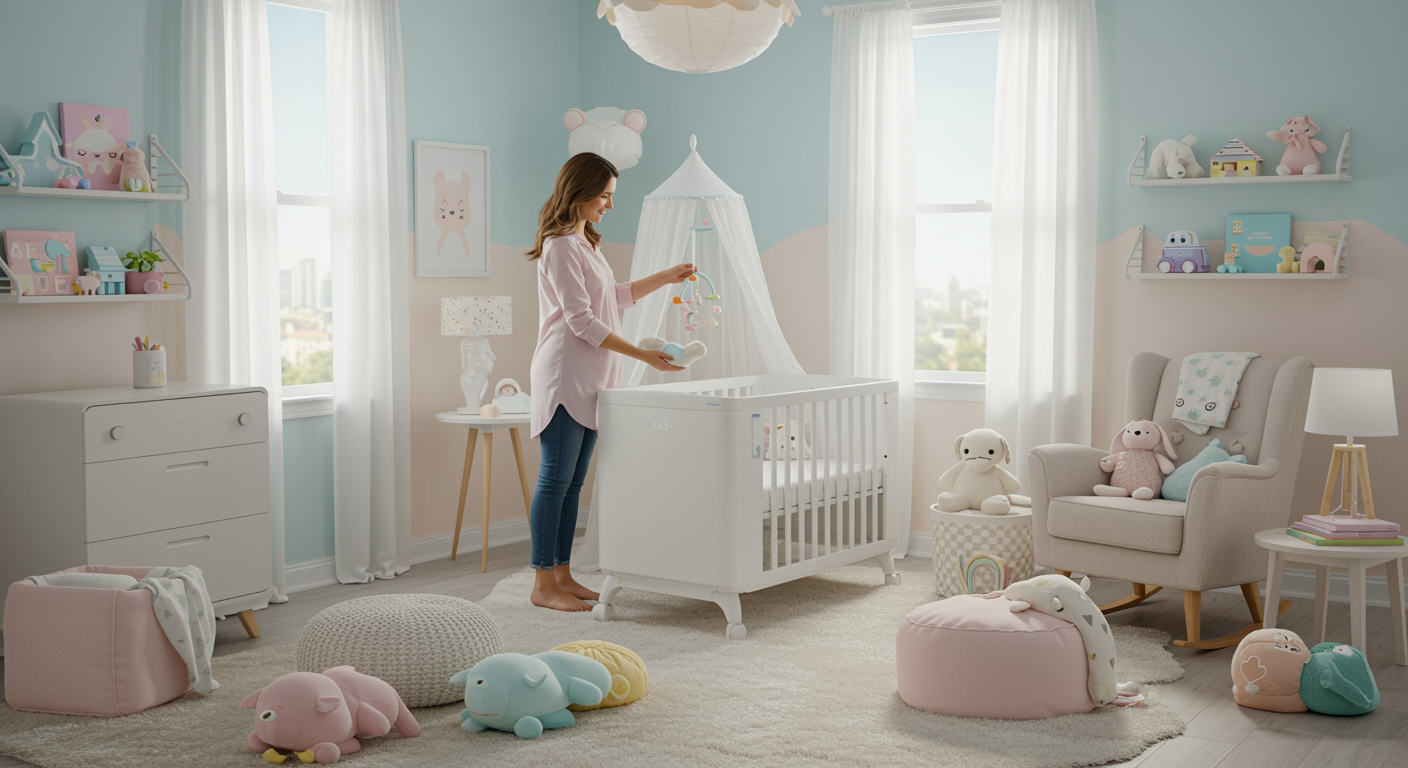Disclaimer: The information and experiences shared in this article are for educational and sharing purposes and do not replace the advice of a qualified professional. Always consult a pediatrician or specialist for questions related to your baby’s health and well-being.
Introduction
Designing a nursery for your baby is an exciting milestone for first-time moms. However, creating a space that is not only beautiful but also functional and conducive to sleep can feel overwhelming. A well-thought-out nursery can help establish healthy sleep habits and provide a calming environment for both you and your baby. This guide will walk you through the essential steps to create a sleep sanctuary that is safe, practical, and soothing.
The Foundations of a Sleep-Friendly Nursery
1. Prioritizing Safety
Safety is the cornerstone of any nursery design. Before focusing on aesthetics, ensure the space meets all safety standards.
- Crib Safety: Choose a crib that meets current safety regulations. Ensure slats are no more than 2 3/8 inches apart, and avoid drop-side cribs.
- Mattress Fit: The crib mattress should fit snugly, with no gaps larger than two fingers between the mattress and the crib frame.
- No Loose Items: Avoid placing pillows, blankets, or stuffed animals in the crib to reduce the risk of suffocation.
- Anchor Furniture: Secure heavy furniture, such as dressers and bookshelves, to the wall to prevent tipping.
2. Optimal Room Temperature and Ventilation
Babies sleep best in a room that is cool and well-ventilated.
- Ideal Temperature: Maintain a room temperature between 68–72°F (20–22°C).
- Air Circulation: Use a ceiling fan or portable fan to improve air circulation, but avoid pointing it directly at the crib.
- Humidity Control: A humidifier can help maintain optimal humidity levels, especially in dry climates.
Designing for Comfort and Functionality
3. Choosing the Right Lighting
Lighting plays a significant role in regulating your baby’s sleep-wake cycle.
- Blackout Curtains: Install blackout curtains to block out natural light during nap times.
- Soft Nightlight: Use a dim nightlight to provide enough visibility for nighttime feedings and diaper changes without overstimulating your baby.
- Adjustable Lighting: Consider a lamp with adjustable brightness to adapt to different needs.
4. Selecting a Comfortable Chair
A comfortable chair is essential for feeding, rocking, and soothing your baby.
- Glider or Rocker: Choose a chair with smooth gliding or rocking motion to help calm your baby.
- Supportive Design: Look for a chair with good back and arm support, and consider adding a footrest or ottoman for added comfort.
Creating a Calming Atmosphere
5. Color Palette and Décor
The colors and décor in the nursery can influence your baby’s mood and sleep.
- Soothing Colors: Opt for soft, neutral tones like pastels, whites, or grays to create a calming environment.
- Minimalist Décor: Avoid overstimulating patterns or bright colors. Keep wall art and decorations simple and serene.
- Personal Touches: Add a few personal touches, such as family photos or a handmade mobile, to make the space feel special.
6. Incorporating White Noise
White noise can help mask household sounds and create a consistent auditory environment.
- White Noise Machine: Invest in a white noise machine with adjustable volume and sound options like rain or ocean waves.
- Placement: Position the machine at least 7 feet away from the crib to ensure safe sound levels.
Organizing for Practicality
7. Efficient Storage Solutions
A well-organized nursery makes daily tasks easier and reduces stress.
- Diaper Station: Set up a dedicated diaper-changing area with all essentials within arm’s reach, including diapers, wipes, and creams.
- Closet Organization: Use bins, baskets, and dividers to keep baby clothes sorted by size and type.
- Toy Storage: Store toys in labeled bins or baskets to keep the room tidy and clutter-free.
8. Accessibility and Flow
Arrange the nursery layout to ensure everything you need is easily accessible.
- Proximity to Crib: Keep essentials like burp cloths, pacifiers, and swaddles close to the crib.
- Clear Pathways: Ensure there’s enough space to move around comfortably, especially during nighttime feedings.
Establishing Sleep Routines
9. Setting Up a Bedtime Routine
A consistent bedtime routine helps signal to your baby that it’s time to sleep.
- Bath and Massage: Start with a warm bath followed by a gentle massage to relax your baby.
- Storytime or Lullabies: Read a short story or sing a lullaby to create a calming transition to sleep.
- Dim the Lights: Gradually dim the lights to help your baby wind down.
10. Avoiding Overstimulation
Keep the nursery environment calm and quiet, especially in the evening.
- Limit Screen Time: Avoid using screens or bright lights in the nursery.
- Quiet Play: Engage in quiet activities like reading or cuddling before bedtime.
Conclusion
Creating a sleep sanctuary for your baby is an investment in their well-being and your peace of mind. By prioritizing safety, comfort, and a calming atmosphere, you can design a nursery that fosters healthy sleep habits and provides a nurturing space for your little one. Remember, every baby is unique, so feel free to adapt these tips to suit your family’s needs. With thoughtful planning, your nursery can become a haven of rest and relaxation for both you and your baby.
